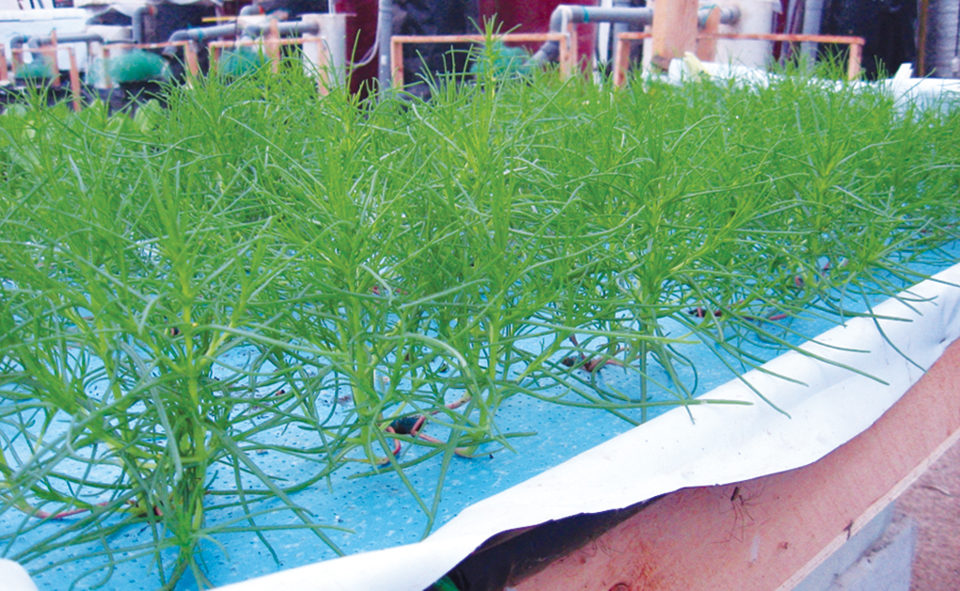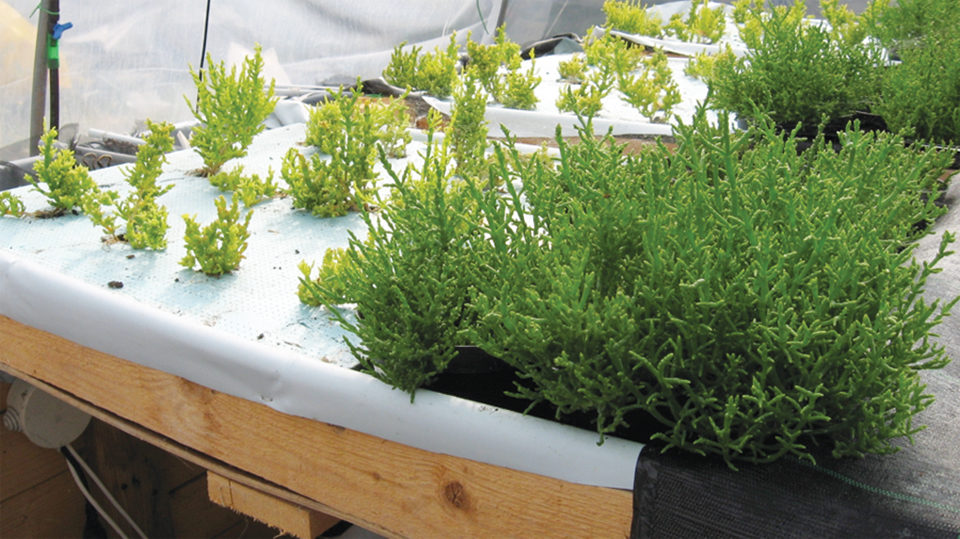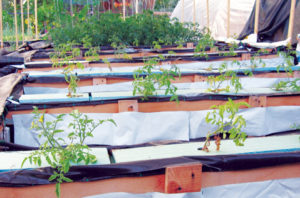Expansion of land-based aquaculture can provide a range of advantages

Aquaculture, as well as agriculture, is nowadays looking at integration as a strategy to limit impacts on natural resources. The use of byproducts can undoubtedly reduce the need for inputs, abate costs and differentiate farm outputs.
However, if on one side freshwater aquaculture can support farmers’ productivity by integrating agricultural systems, on the other side, marine aquaculture is still confined in open water management, which eventually limits its potential.
The development of multitrophic aquaculture, which integrates fish with algae and shellfish, is a valid strategy to improve productivity and reuse fish wastes, but it is far from achieving a full recovery of pollutants due to dilution in open water. Land operations for marine aquaculture could not only be a valid alternative for farmers but would boost saline agriculture, provided that proper levels of nutrients are supplied to plants.
Recent studies at the University of Tuscia in Italy unveiled the potential for integrating aquaculture with saline agriculture, whose economic and environmental benefits could easily overcome the higher initial investment costs for land operations.
Lessons from aquaponics
In many countries, aquaponics – soilless/hydroponic plant production using aquaculture wastes – has been used to get rid of fish by-products through the production of high-value vegetables. Aquaponics has many advantages in terms of bioremediation, water recycling and sustainable food production.
Fish wastes are nutrients for plants, which grow with no external fertilization. At the same time, plant roots act as natural biofilters and absorb metabolites toxic to fish from the water that returns back to aquaculture tanks.
Although the levels of nutrients in aquaponics are very low compared to traditional hydroponics, growth is as productive as intensive agricultural systems due to the continuous supply of minerals from the fish and the presence of plant-beneficial microorganisms that live in the systems. Furthermore, research carried out in Italy on production quality between aquaponics and hydroponics found similar quality traits in both systems.
Despite their often high-tech appearance, aquaponic systems are quite robust, and management is not as difficult as it may appear. Conversely, the synergies between fish and plants make the production of vegetables more profitable than aquaculture alone.
Regardless of the system, a key point of fish-plant integration is the level of nutrients released by animals, which is higher in recirculating water. Flow-through systems are in general not as productive as closed systems, due to scarce nutrient build-up. In the case of recirculating systems, the low levels of minerals are sufficient to obtain good yields because fish continuously replenish plant uptake.
Marine agriculture
The development of saline agriculture follows different strategies from traditional farming. It is well known that crops cannot grow in full-strength seawater, since plants are not tolerant of salt. Nevertheless, plants and fish can grow under moderate salinity, which favor both plants and animals, the latter due to lower energy consumption for osmoregulation.
In horticulture, specific agronomic strategies allow tomato farming under moderate salinity at levels compatible with European seabass, Dicentrarchus labrax, and gilthead sea bream, Sparus aurata, production. The addition of salty water is indeed a common horticultural practice used for raising the quality of certain vegetables.
The increase of osmotic pressure reduces plant water intake, which eventually brings positive effects on taste, nutritional values and shelf life. On the other hand, the production of certain medicinal plants is favored by saline stress, which enhances the concentrations of the active molecules used by the pharmaceutical industry.

Choice of plants
The lion’s share of marine agriculture involves halophytes, salt-tolerant plants that can be chosen according to available salt and nutrient concentrations. Most halophytes are resistant to drought conditions, which make them suitable in areas where traditional agriculture cannot be developed.
Some halophytes have been cultivated for ages for culinary uses, raised as staples for human and animal consumption or used for energy production.
Salicornia, also known as sea asparagus or samphire, grows spontaneously in salty marshlands near coastlines. It is consumed fresh or pickled, but also added to feed formulations due to the good protein content of the seeds. High oil-yielding varieties of salicornia are farmed for biodiesel production in tropical climates.
In the leaf vegetable market, it is worth mentioning sea beet, a close relative of the common chard that does not significantly differ from commercial varieties. The plant is particularly interesting for its crispy texture and slightly salty taste, which could be an added-value quality for the market.
For staple production, pearl millet and quinoa show great potential. Quinoa was the second most-cultivated crop raised by indigenous populations in South America, soon after potatoes but before maize in production. Unfortunately, under modern agriculture, quinoa did not reach the same success as the other two staples, although it has twice the protein of wheat and is very rich in all the essential amino acids. Its drought resistance and limited need of nutrients can boost the interest for integrated systems aiming at food or feed production of superior nutritional values.
Research evidence
Halophytes are salt-tolerant plants, but for each species, optimal growth is obtained within certain salinity ranges. Trials carried out in aquaponic systems at the University of Tuscia indicated that the best performances for most plants were obtained under salinity levels up to 10 ppt. Nutrient concentrations and environmental variables also played important roles in productivity, since optimal nitrogen levels, temperature and pH enhanced vegetative growth and maturation in plants.
Salsola trials showed maximum yields under salt concentrations of 10 ppt, although the plants performed fairly well up to 20 ppt. Interestingly, productivity from the aquaponic systems – 2.2-3.2 kg/m2 in four-week crop cycles – was similar or even higher than for chemically fertilized hydroponics. Retail prices of €4.0-4.5/kg (U.S. $5.35 to $6.00/kg) make this vegetable an appealing plant for fast paybacks on capital investments.
Sea beet showed yields of 2.6 kg/m2 at 10 ppt in four weeks, but contrary to the conditions for salsola, its salinity optimum was identified at lower concentrations. Salicornia showed similar biomass trends from a 90-day crop cycle on sand beds. Best growth was observed under lower salinity and decreased under salt concentrations of 20 ppt. Although salicornia in aquaponics had similar or higher yields than under hydroponics – 5.2-7.4 kg/m2 versus 5.8 kg/m2 – it was observed that rises in nutrient concentrations determined faster plant growth and maturity.
Perspectives

Large-scale aquaculture operations can benefit from integrated management, provided that appropriate system designs develop cost-effective production. The optimal salinity ranges for halophytes suit most of the aquatic animals’ needs. However, the adoption of advanced management strategies for both plants and fish would open new opportunities for the farming of less salt-tolerant species or traditional horticulture.
The adoption of different aquaponic systems, including discontinuous and pre-enriched open systems, would be more suitable for farming perennial or annual crops and to avoid salt build-up in soil. More research is needed to define precise guidelines for saline systems management.
In the future vision of sustainability, the expansion of agriculture in dry or saline areas would be one of few options available to support world food production without destroying forests. In this scenario, aquaculture can be a key factor in achieving food/energy production goals through the simple supplement of water and nutrients from fish.
The expansion of land-based aquaculture can provide a range of advantages. Production is pollution-free because there is no dispersion of wastes into seawater. Fish and plants grow under controlled conditions that can be adjusted to meet optimal growth levels. Fish are less prone to parasites from the sea. Farming integration can reduce the production footprint due to full recovery of wastes. Production is greener and can more easily meet market demand for food with carbon dioxide labeling.
(Editor’s Note: This article was originally published in the January/February 2012 print edition of the Global Aquaculture Advocate.)
Author
-
Edoardo Pantanella, M.S.
Department DAFNE
University of Tuscia
Faculty of Agricultural Science
Viterbo 01100 Italy[109,111,99,46,108,105,97,109,103,64,97,108,108,101,110,97,116,110,97,112,100,101]
Tagged With
Related Posts

Health & Welfare
A holistic management approach to EMS
Early Mortality Syndrome has devastated farmed shrimp in Asia and Latin America. With better understanding of the pathogen and the development and improvement of novel strategies, shrimp farmers are now able to better manage the disease.

Responsibility
A look at integrated multi-trophic aquaculture
In integrated multi-trophic aquaculture, farmers combine the cultivation of fed species such as finfish or shrimp with extractive seaweeds, aquatic plants and shellfish and other invertebrates that recapture organic and inorganic particulate nutrients for their growth.

Aquafeeds
A look at protease enzymes in crustacean nutrition
Food digestion involves digestive enzymes to break down polymeric macromolecules and facilitate nutrient absorption. Enzyme supplementation in aquafeeds is a major alternative to improve feed quality and nutrient digestibility, gut health, compensate digestive enzymes when needed, and may also improve immune responses.

Health & Welfare
10 paths to low productivity and profitability with tilapia in sub-Saharan Africa
Tilapia culture in sub-Saharan Africa suffers from low productivity and profitability. A comprehensive management approach is needed to address the root causes.


